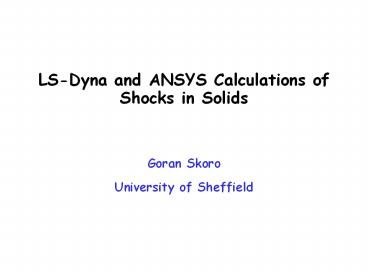LS-Dyna and ANSYS Calculations of Shocks in Solids PowerPoint PPT Presentation
Title: LS-Dyna and ANSYS Calculations of Shocks in Solids
1
LS-Dyna and ANSYS Calculations of Shocks in Solids
- Goran Skoro
- University of Sheffield
2
(No Transcript)
3
(No Transcript)
4
Codes used for study of shock waves
- Specialist codes eg used by Fluid Gravity
Engineering Limited Arbitrary
Lagrangian-Eulerian (ALE) codes (developed for
military) - Developed for dynamic e.g. impact problems
- ALE not relevant? Useful for large deformations
where mesh would become highly distorted - Expensive and specialised
- LS-Dyna
- Uses Explicit Time Integration (ALE method is
included) - suitable for dynamic e.g. Impact problems
- Should be similar to Fluid Gravity code
- ANSYS
- Uses Implicit Time Integration
- Suitable for Quasi static problems
5
Implicit vs Explicit Time Integration
- Explicit Time Integration (used by LS Dyna)
- Central Difference method used
- Accelerations (and stresses) evaluated
- Accelerations -gt velocities -gt displacements
- Small time steps required to maintain stability
- Can solve non-linear problems for non-linear
materials - Best for dynamic problems
6
Implicit vs Explicit Time Integration
- Implicit Time Integration (used by ANSYS) -
- Finite Element method used
- Average acceleration calculated
- Displacements evaluated
- Always stable but small time steps needed to
capture transient response - Non-linear materials can be used to solve static
problems - Can solve non-linear (transient) problems
- but only for linear material properties
- Best for static or quasi static problems
7
PART I
- Hydrocode (FGE) and ANSYS results
8
(No Transcript)
9
Study by Alec Milne Fluid Gravity Engineering
Limited
- Alec Milne
- We find that these models predict there is the
potential for a problem . These results use 4
different material models. All of these show that
the material expands and then oscillates about an
equilibrium position. The oscillations damp down
but the new equilibrium radius is 1.015cm. i.e.
an irreversible expansion of 150 microns has
taken place. The damping differs from model to
model. The key point is all predict damage.
10
ANSYS benchmark study same conditions as Alec
Milne/FGES study i.e.?T 2000 K
The y axis is radial deflection (metres)
11
(No Transcript)
12
Elastic shock waves in a candidate solid Ta
neutrino factory target
- 10 mm diameter tantalum cylinder
- 10 mm diameter proton beam (parabolic
distribution for simplicity) - 300 J/cc/pulse peak power (Typ. for 4 MW proton
beam depositing 1 MW in target) - Pulse length 1 ns
13
Elastic shock waves in a candidate solid Ta
neutrino factory target
Temperature jump after 1 ns pulse (Initial
temperature 2000K )
14
(No Transcript)
15
PART II LS-Dyna results
- General purpose explicit dynamic finite element
program - Used to solve highly nonlinear transient dynamics
problems - Advanced material modeling capabilities
- Robust for very large deformation analyses
- LS-Dyna solver
- Fastest explicit solver in marketplace
- More features than any other explicit code
16
Material model used in the analysis
- Temperature Dependent Bilinear Isotropic Model
- 'Classical' inelastic model
- Nonlinear
- Uses 2 slopes (elastic, plastic) for representing
of the stress-strain curve - Inputs density, Young's modulus, CTE, Poisson's
ratio, temperature dependent yield stress, ... - Element type LS-Dyna Explicit Solid
- Material TANTALUM
17
(No Transcript)
18
First studies
- Because the target will be bombarded at up 50 Hz
by a proton beam consisting of 1ns long bunches
in a pulse of a few micro-s length we have
studied - The effect of having different number of bunches
in a pulse - The effect of having longer bunches (2 or 3 ns)
- The effect of different length of a pulse.
19
(No Transcript)
20
(No Transcript)
21
Characteristic time radius / speed of sound in
the tantalum
22
(No Transcript)
23
(No Transcript)
24
(No Transcript)
25
BUT,
- At high temperatures material data is scarce
- Hence, need for experiments to determine material
model data (J.R.J. Bennett talk) - Current pulse through wire (equivalent to 300
J/cc) - Use VISAR to measure surface velocity
- Use results to 'extract' material properties at
high temperatures... - and test material 'strength' under extreme
conditions....
26
(No Transcript)
27
(No Transcript)
28
(No Transcript)
29
(No Transcript)
30
heat input stops
31
(No Transcript)
32
(No Transcript)
33
Summary
- Results (NF)
- The effect of having different number of bunches
(n) in a pulse at the level of 10-20 when n1
-gt n10 - The effect of having longer bunches (2 or 3 ns)
No - The effect of different length of a pulse Yes
- Results (test, wire)
- Estimate of surface velocities needed for VISAR
measurements

